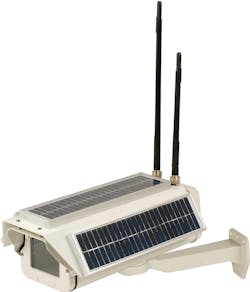Surveillance: The Evolution of Wireless Technologies
Remove the constraints of traditional hardwired IP video surveillance—such as cabling, infrastructure and power—and a brave new world of deployment possibilities open to systems integrators and their customers.
For those customers hand-tied to the restraints of IP video surveillance, a true wireless solution delivers a host of new options. No power source nearby? Impossible to reach a hardwired infrastructure for your LAN deployment? A remote location that mandates perimeter security but never had the reliability with former equipment? Now there is a solution for each of these challenges. With new and improved wireless surveillance camera capabilities, more installation options abound, including public events, venues or government gatherings, construction sites, agricultural areas, law enforcement and public safety, recreational facilities, transportation, utilities, commercial sites and parking facilities.
Traditional, first-generation wireless cameras required cabling for power, and routing the power source remains a major impediment to the broad adoption of wireless cameras in a variety of applications. While wireless cameras sometimes deliver adequate video quality, system integrator never had the confidence that these wireless solutions would have the quality and reliability to rely on these solutions. Common problems included dropped connections, interference issues with other wireless devices causing image quality and the collapse of surrounding Wi-Fi networks. These issues created a direct impact on the perception and adoption of wireless technologies. But the issues above are no longer a reality. Today’s next generation wireless providers have made significant strides in the development of more robust solutions.
Solid returns on investment
Labor remains one of the highest costs of the installation of any traditional security project, including video surveillance. Some say labor can be as much as 60 percent of a job’s costs, even more depending on man-hours required to dig or trench, and pull wire and cable. Trenching costs range from $50 to $1,000 per foot. For example, 100 yards of trenching can cost anywhere between $22,000 and $45,000 with anywhere from two to four weeks of completion time. Often times heavy equipment must be purchased or leased, driving costs up further.
Yet surveillance is such a critical part of effective perimeter detection and security and is at the very heart of any security plan’s overall effectiveness. Therefore, the protection of outdoor areas cannot be ignored.
It’s easy to see why wireless is winning the favor of many installers and end users who dread digging or trenching. For the installer, the return on investment of deploying wireless surveillance solutions presents itself in numerous ways. At its core, wireless technology solves the problem of requiring a cable for data transmission but placing a camera where there is no available power source made it impossible to implement. In other cases, a power source was available but the wireless solution had limited range, requiring the installer to consider trenching for a Power over Ethernet (PoE) solution, adding to project cost and complexity.
New wireless surveillance technologies do not have these limitations. Today’s advanced solutions are fully self-contained wireless video cameras that allow for placement anywhere because there are no wires needed for power or data transmission. These systems also incorporate removable antennas, using shorter antennas to provide more margin for easier alignment and installation or substitute higher gain antennas for longer-range operation.
Opportunities abound
With this solution in hand, integrators and installers can return to existing qualified customers with new solutions to outdoor surveillance challenges as well as reach users with opportunities for surveillance in untapped applications and vertical markets. Wireless has changed in other ways as well. It’s more robust and batteries have longer life.
Next-generation wireless cameras are built from the ground up for surveillance with a proprietary wireless protocol developed to overcome the unique challenges of transferring high bandwidth video over the air efficiently. These devices leverage the intelligence of a new type of wireless protocol to allow control data from a central networking hub to be communicated over the 915 MHz, while the 2.4 GHz band transfers the stream of video data. Unlike other wireless surveillance cameras that transfer data when it is ready, new systems leverage intelligent software to transfer data only when it detects an empty ‘airspace,’ meaning minimal interference with other devices. This decreases the opportunity for packet collisions and interference. Also, these advanced algorithms are more efficient than standard Wi-Fi retransmit, requiring less airtime when transmitting compressed video. Using a a proprietary video protocol results in an inherent security feature, as standard WiFi intrusion devices are not compatible.
Developed specifically for use in wireless surveillance deployments, this advancement helps users get the most reliability and security from the complete solution.
Robust wireless surveillance systems also detect when a camera or video connection is lost and take immediate action to counteract and recover the connection. With automatic recovery, the VMS system eliminates numerous fals alarms that are generated from the numerous “video loss” detections that had resulted from the use of first generation wireless cameras.
In the field, solar cells power the camera for outdoor applications and provide round-the-clock video surveillance system operation with an integrated battery that allows continuous 365/24/7 operation, since the batteries can last over five days without additional recharge. Overall, this provides end users with a solution that can truly protect a wide-ranging perimeter environment in a cost-effective and reliable manner. The misconceptions of wireless technology are no longer applicable, and security teams can now realize the true benefit of wireless surveillance, beginning with effective perimeter security surveillance.
Removing the constraints of video surveillance — such as cabling and infrastructure — opens up a world of possibilities for systems integrators. Now they can complete jobs faster and add more projects to the queue. Integrators can also go back to current clients to offer wireless where perhaps they couldn’t before, or where a new need has arisen. They can offset the high costs of cabling with more and quicker deployment of installations — and continue to show their expertise in the surveillance field.
